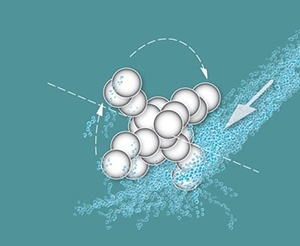
New way of driving nanomotors
Leiden Physicists have found evidence for the Berry-force that could be used for driving tiny nanomotors, just like a river drives a water wheel. Nanomotors could be used for drug delivery in the human body. Publication in Beilstein Journal of Nanotechnology.
A few single atoms in a row
Experimental physicist Jan van Ruitenbeek and his group take extremely small metal chains consisting of only a few single atoms in a row and send an electric current through. When the chain breaks, they repeat the process, up to thousands of times. In most cases it breaks in a similar way as the filament of a light bulb that has burnt out: the electric current heats the chain until it becomes too hot and falls apart.
Two forces
The weird phenomenon is that some of the chains break at a surprisingly low voltage. This was already measured more than ten years ago, but could not be explained. Now, first author Carlos Sabater thinks he found the reason; a combination of two forces acts on the chains, the so-called wind force and the Berry force. Together they cause the chain beads to move and rotate so much that the bond between them breaks.
Driving force

These forces resemble a river moving a water wheel. Therefore, they could be of great use for driving rotating parts in nanomotors. Conventional nanomotors only work if they are driven by a cyclic force, which makes things very complicated. However, nanomotors based on the Berry and wind force only need a simple electric direct current. A stream of electrons continuously pumps energy into the metal atoms via the wind force, while the Berry force causes them to rotate.
Application of nanomotors
These have a wide range of possible applications and could for example be used for drug delivery in the body.
Berry-force
Until now, the Berry force has never been demonstrated experimentally. The direct observation of a rotating nanowheel is very challenging, but the breaking atom chains are an indirect proof for it. The now published results match very precisely with theoretical predictions. The researchers continue to work on more direct ways of monitoring the force.
Header image: llustration of nanorobots destroying diseased tissue inside a human blood vessel.
